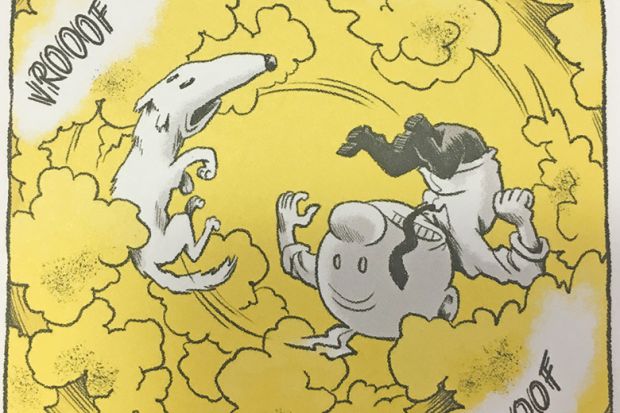Can graphic means help non-specialists to understand some of the deepest questions in physics? Two recent books offer rather different attempts to do so.
In Mysteries of the Quantum Universe (Particular Books), French theoretical physicist Thibault Damour and illustrator Mathieu Burniat adopt the medium of a graphic adventure novel. Explorer Bob and his dog Rick (pictured above) are confused by how the universe works, so they set out on a quest and cross-examine star physicists such as Niels Bohr, Albert Einstein, Werner Heisenberg, Max Planck and Erwin Schrödinger about their different interpretations. At one point, Bob reflects that he has learned something important, namely that “the electron was not a classical object like a billiard ball but rather a…a thingy whose very nature remains shrouded in mystery”. Readers may enjoy both the intellectual workout and the highly entertaining images but still be left similarly baffled.
But perhaps that is part of the point. The other book – by Jorge Cham, creator of PHD Comics, and Daniel Whiteson, professor of experimental particle physics at the University of California, Irvine – incorporates cartoons on every page and is boldly titled We Have No Idea: A Guide to the Unknown Universe (John Murray).
“We are mostly clueless about what the universe is filled with (dark matter)”, they write, “and how to describe the most powerful forces that control it (dark energy, quantum gravity). It seems our mastery applies to only a tiny corner of the universe, and we are surrounded by a vast ocean of ignorance.” Such ignorance can admittedly be described as “precision ignorance”, because we know that the universe consists of 5 per cent regular matter, 27 per cent dark matter and 68 per cent dark energy, we just have “no idea what [these things] are”. Today’s “science is mostly just drinking coffee with the occasional flash of insight and rare afternoons of actual progress”.
And so we embark on a tour of all the things we don’t know. We are confused by the nature of mass and space and time. We can only speculate about what happened during the Big Bang, how big the universe is and whether we are alone in it. It might not sound very interesting to read a book where the authors, who are meant to be the experts, keep repeating that they “just don’t know”, but Cham and Whiteson keep up the pace with a combination of hard science, inventive analogies and gags.
“If extra dimensions exist,” they ask at one point, “could we use them as storage for our shoes or to hide our extra stomach fat? Or build shortcuts to work or even to distant stars? These ideas sound absurd, but the truth of nature is no stranger to absurdity.” Furthermore, the existence of extra dimensions might help to explain the (apparently) unexpected weakness of gravity as a force, by allowing it to be “diluted into all the different dimensions” – just as a fart in a narrow hallway smells worse than one “released at the intersection of several hallways”.
